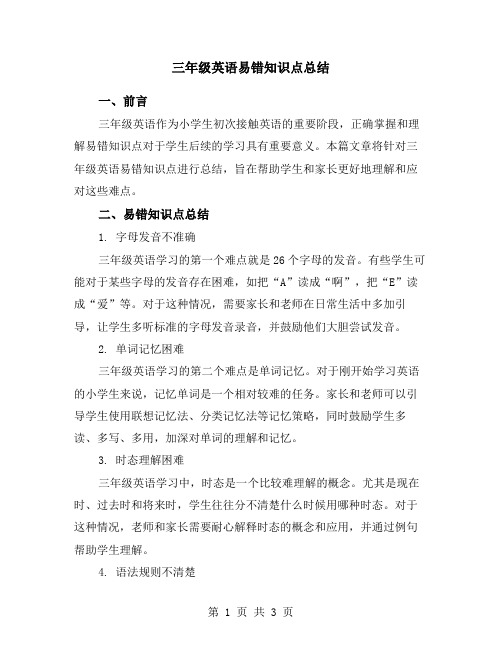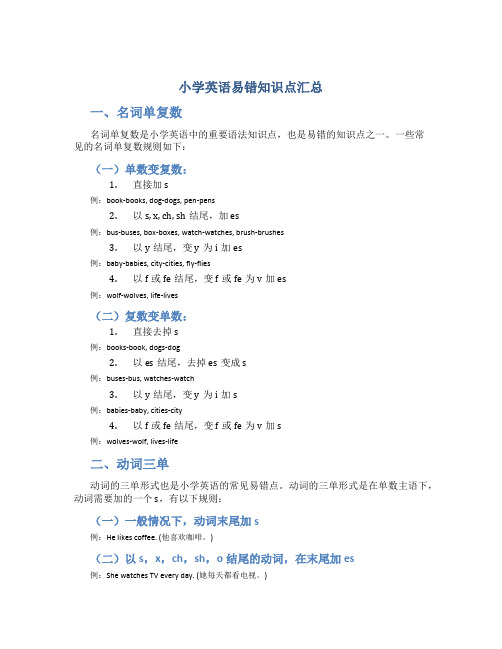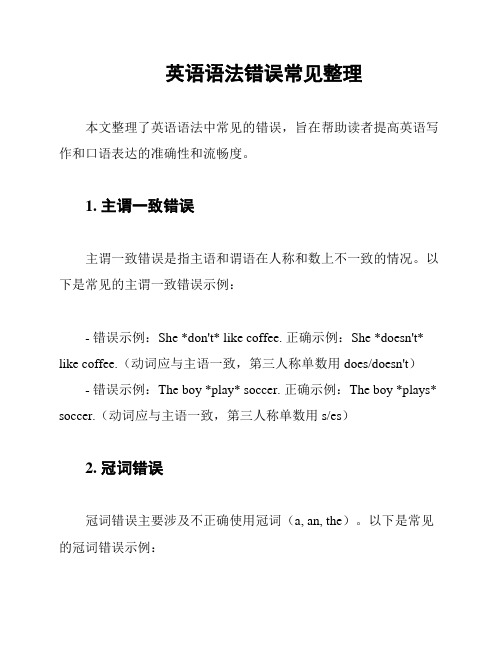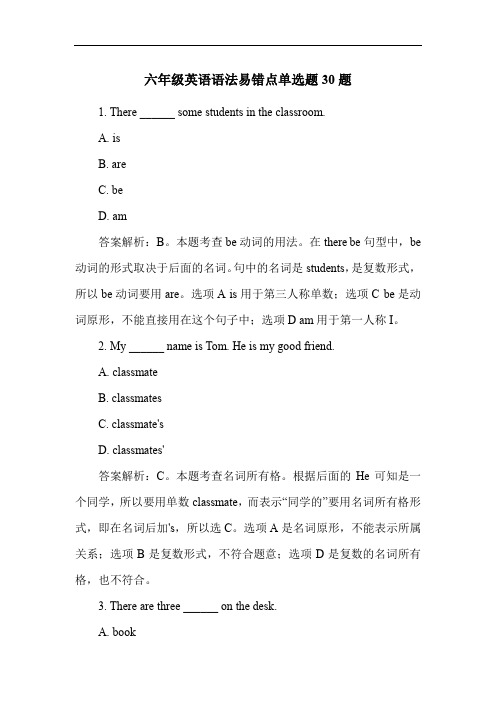小学英语考试语法易错点汇总
小学英语易错知识点汇总

小学英语易错知识点汇总小学英语是中国学生必修的科目之一,学好英语不仅可以为将来升学打下基础,还可以帮助我们更好的理解和应用英语。
在学习英语的过程中,常常会遇到一些易错的知识点。
下面将从单词、语法和阅读理解三个方面总结一些小学英语易错知识点。
单词1. 单词拼写拼写是英语学习中最基础、也是最实用的技能之一。
在小学阶段,学生要掌握很多单词,但因为易错的原因,难免出现错拼的情况。
下面列出一些易错单词和记忆技巧。
•vegetable(蔬菜):有时候学生容易拼成vegetbale或vegetalbe,正确记忆应该是“vege + table”,就像“桌子上有蔬菜。
”•beautiful(美丽的):这个单词的拼写似乎比较复杂,有时候学生会将其拼成beatiful或beutiful。
正确的记忆应该是“beauty + full”,就像“非常美丽”。
•restaurant(餐馆):这个单词的末尾有个t,有时候会被忽略。
正确的记忆方法是用旁边两个字母au,记住这个单词比“au”更长。
2. 词性转换在英语中,同一个单词可以在不同的句子中表现出不同的词性。
掌握词性转换是英语学习的重要部分,下面将提供一些易错的词性转换。
•happy(开心的):这个单词在转化为名词时是happiness,而不是happyness。
•run(跑):这个单词在转化为名词时是“run”,而不是“running”。
•easy(容易的):这个单词在转化为副词时是“easily”,而不是“easyly”。
语法1. 英文句型的还原在英语中,有时候需要将一句话改为其他句型。
这种能力对于学生来说非常重要,但也非常容易出错。
下面提供一些易错的英文句型还原。
•There is a cat under the table.(桌子底下有一只猫):改为疑问句可以是“Is there a cat under the table?”,而不是“There a cat under the table?”。
小学四年级英语考试知识点汇总

小学四年级英语考试知识点汇总小学四年级英语考试是小学英语学习中的一个重要阶段。
在此阶段,学生需要掌握一些基础的英语知识点和语法规则。
下面是对小学四年级英语考试知识点的汇总。
一、语法知识点1.系动词的用法:be动词、feel、seem、look、sound等。
2.动词时态:一般现在时、过去式、将来时、一般过去时等。
3.现在分词和动词-ing的用法。
4.名词的单数和复数形式。
5.代词的用法:主格、宾格、形容词性和名词性等。
6.形容词的比较级和最高级的用法。
7.副词的用法。
8.介词的用法。
9.数词的用法:基数词和序数词等。
10.祈使句的用法。
二、词汇知识点1.常见动词的词形变化。
2.常见名词的单数和复数形式。
3.常见形容词和副词的词形变化。
4.常见介词和连词的用法。
5.常见数词的词形和用法。
三、听力理解小学四年级英语考试中的听力理解部分通常包括以下内容:1.听力材料的类型:对话、短文、歌曲等。
2.听力材料的主旨。
3.听力材料中的细节信息。
4.听力材料中的人物、时间和地点等基本信息。
四、阅读理解小学四年级英语考试中的阅读理解部分通常包括以下内容:1.阅读材料的类型:短文、图表等。
2.阅读材料的主旨。
3.阅读材料中的细节信息。
4.阅读材料中的生词和短语的理解。
五、写作表达小学四年级英语考试中的写作表达部分通常包括以下内容:1.句型的正确性。
2.词汇的正确使用。
3.文章的段落结构和连贯性。
4.语法和拼写的正确性。
六、口语表达小学四年级英语考试中的口语表达部分通常包括以下内容:1.熟练掌握基础的口语表达能力。
2.表述清晰,语音准确。
3.能准确使用所学的语法和词汇。
七、考试技巧小学四年级英语考试中,除了掌握以上基础知识点外,还需要具备一定的考试技巧,以保证考试的高分。
1.提前准备:提前熟悉考试内容和考试形式。
2.注意时限:合理利用考试时间。
3.精读题目:仔细阅读题目,理解题目要求。
4.注意答题顺序:先完成易答、短答题目,再解答难题。
三年级英语易错知识点总结

三年级英语易错知识点总结一、前言三年级英语作为小学生初次接触英语的重要阶段,正确掌握和理解易错知识点对于学生后续的学习具有重要意义。
本篇文章将针对三年级英语易错知识点进行总结,旨在帮助学生和家长更好地理解和应对这些难点。
二、易错知识点总结1. 字母发音不准确三年级英语学习的第一个难点就是26个字母的发音。
有些学生可能对于某些字母的发音存在困难,如把“A”读成“啊”,把“E”读成“爱”等。
对于这种情况,需要家长和老师在日常生活中多加引导,让学生多听标准的字母发音录音,并鼓励他们大胆尝试发音。
2. 单词记忆困难三年级英语学习的第二个难点是单词记忆。
对于刚开始学习英语的小学生来说,记忆单词是一个相对较难的任务。
家长和老师可以引导学生使用联想记忆法、分类记忆法等记忆策略,同时鼓励学生多读、多写、多用,加深对单词的理解和记忆。
3. 时态理解困难三年级英语学习中,时态是一个比较难理解的概念。
尤其是现在时、过去时和将来时,学生往往分不清楚什么时候用哪种时态。
对于这种情况,老师和家长需要耐心解释时态的概念和应用,并通过例句帮助学生理解。
4. 语法规则不清楚三年级英语学习的另一个难点是语法规则。
有些学生对于主语、谓语、宾语等概念不清楚,或者对于一些基本的语法规则如动词的变化、句子的结构等掌握不准确。
对于这种情况,老师和家长需要注重语法知识的讲解,并通过例句和练习帮助学生理解和掌握。
三、应对策略1. 培养良好的学习习惯对于三年级英语易错知识点,学生需要养成良好的学习习惯。
如每天坚持听录音、认真记笔记、积极参与课堂活动等。
同时,家长和老师也要给予学生足够的支持和鼓励,帮助他们树立学习英语的信心。
2. 注重基础知识的掌握对于字母、单词、时态、语法等基础知识,学生需要认真掌握。
可以通过多读、多写、多用等方式,加深对这些知识点的理解和记忆。
同时,家长和老师也要及时检查学生的学习情况,发现问题及时纠正。
3. 积极参加课外活动为了更好地理解和应用所学知识,学生可以积极参加课外英语活动,如英语角、英语比赛等。
小学英语考试易错知识点汇总(附易错题)

小学英语考试易错知识点汇总(附易错题)1、写出完全形式:1.who's=who is2.she's = she is3.he's = he is4.what's = what is5.where’s= where is6.we're = we are7.you're = you are8.that's = that is9.I'm = I am10.isn't = is not11.aren't = are not12.they're = they are13.don't = do not14.let's = let us15.can’t = can not16. it's = it is17. I’ve = I have18. I’d = I would19. hasn’t = has not2、写出下列单词的复数形式:1.bus ——buses2.box ——boxes3.glass ——glasses4.class ——classes5.watch ——watches6.mango ——mangoes7.firefly ——fireflies8.sheep ——sheep9.people ——people10.man ——men11.woman ——women12.apple ——apples13.family ——families14.library ——libraries15.baby ——babies16.boy ——boys17.toy ——toys18.child ——children19.foot ——feet20.strawberry—strawberries21.horse ——horse22.policeman—policemen23.dress ——dresses24. fish ——fish25.tooth ——teeth26.country —countries27. foot ——feet28.dragonfly —dragonflies29.me ——us30.building——buildings31. cloth——clothes32. this ——these33. that ——those34.circle ——circles35.story ——stories 3、反义词或对应词:1.same ——different2.new ——old3.old ——young4.short ——long5.big ——small6.tall ——short7.yes ——no8.open ——close9.hot ——cold10.here ——there11.sit ——stand12.up ——down13.thin ——fat14.father ——mother15.right ——wrong16.black ——white17.this ——that18.these ——those19.boy ——girl20. grandfather ——grandmother21.man ——woman22.husband ——wife23.aunt——uncle24.brother——sister25. he ——she26. left ——right27. go ——come28. nurse ——doctor29. good ——bad30. minus ——plus31. his ——her32. busy——free33. hand ——foot34. legs ——arms 4、近义词:1. desk——table2. like——love3. often——usually4. start——begin5. great——good 5、同音词:1. to too 、two2. right write3. no know4. for four5. hear here6. I eye7. see (C) sea8. son sun9. be (B) bee10. there their11. U you12. Y why13. by buy 、bye14. pair pear15. R are16. whose who’s17. aunt aren’t6、现在分词:1. swim ( 现在分词)——swimming2. come( 现在分词)——coming3. dance (-ing形式)——dancing4. ski (-ing形式) ——skiing5. sit (-ing形式)——sitting6. fly (-ing形式) ——flying7. stay (-ing形式) ——staying8. travel (-ing形式) ——travelling9. cry (-ing形式) ——crying10. play (-ing形式) ——playing11. listen (-ing形式) ——listening12. collect (-ing形式) ——collecting13. make (-ing形式) ——making14. take (-ing形式) ——taking15. write (-ing形式)——writing16. read(-ing形式) ——reading17. clean (-ing形式) ——cleaning18. sing (-ing形式)——singing19. sweep (-ing形式) ——sweeping20. run (-ing形式) ——running7、综合:1. study (第三人称单数)——studies2. students(名词所有格)——students’3. sister(名词所有格)——sister’s4. two(序数词) ——second5. have(第三人称单数)——has6. cat (名词所有格) ——cat’s7. Tom(名词所有格) ——Tom’s8.teacher(动词) ——teach9. cry(第三人称单数) ——cries10.Nancy(名词所有格) ——Nancy’s11. can(否定式) ——can’t12. good(比较级)——better13.catch(第三人称单数) ——catches14. wash (第三人称单数)——washes15. quickly(形容词) ——quick16. visit(名词) ——visitor17. China(形容词) ——Chinese18. French(名词) ——France19. quiet(副词) ——quietly20. one(序数词) ——first21. cook(第三人称单数) ——cooks22. do(第三人称单数) ——does23. beautifully(形容词) ——beautiful24. many (比较级) ——more25. Australian(名词)——Australia26. brush(第三人称单数) ——brushes27. work(名词)——worker好啦,今天的干货内容就分享到这里啦~ 给同学们还收集了一些易错题快来测一测吧!易错题集锦1.What are these?_____ .A.That’s a bookB.They are booksC.It’s a bookD.These are books2.May I try on the jeans? Yes,you_____ .A.shouldB.canC.mustD.need3.We can see some apples ______ the tree and a bird ______ the tree.A.in,onB.on ,inC.in,inD.on,on4.Are you going to ______now?No,not now. ______ are having dinner.A.Turner’s,The TurnersB.the Turner,TurnersC.the Turners’,The TurnerD.Turners,the Turners5.How many birds are there in the tree?______ .A.It’s threeB.There isn’t anyC.They are threeD.There aren’t any6.I’ve got five____ and two ___ .A.photo,tomatoB.photoes,tomatoesC.photos,tomatoesD.photos,tomatos7.How much orange ______ in the bottle?A.there isB.is thereC.there areD.are there8.Have you got any meat?______A. No,I haven’t gotB.Yes,I gotC.Yes, I haveD.No, I got9.Are there any______ on the farm?A.horseB.chikenC.sheep10.______ lessons are very interesting.A..SwimB.SwimingC.Swimming11.The new film is ______ tonight.A.inB. onC. forD.at12.Would you like to come to my party? Yes,A.I wouldB.I doC. I’d loveD.I’d love to13.Daming’s sister______ beautiful clothes on Sunday.A.puts onB.wearC.put onD.wears14..My brother is ______the school football team.A. inB.onC. atD.for15.Look!_____A.Here the bus comesB.Here comes the busC.The bus comes hereD.Here the bus come16.The young man likes ___a black hat.A.To put onB.wearsC.wearingD.putting on17. ______down your names on the paper.A.To writeB.WritesC.WriteD.Writing18.Do you often______ the Internet?A.surfB.sendC. giveD.make19.They sometimes ___ some articles from the computer.A.openB.printC.downloadD.visit20.We______ send emails to friends.A.don’t oftenB.often don’tC.not oftenD.aren’t often21.Dad,______is my deskmate,Xiao Hua.A.heB.sheC.thisD.that22.What are these?___ are feet.A.TheseB. ItC. TheyD. They’re23. What’s______ like in autumn?A.weatherB.the weatherC.a weather24.He can______ .A.cookB.cooksC.to cook25.I like______ .A.singB.singingC.sings26.Dad,this is Miss White.___ ,Miss White?A.What’s your nameB.How do you doC.HelloD.How vare you27. ____,what’s your name?A.HiB.GoodC.SorryD.Yes28.Martin,please sit down.____.A.I’m OKB.Nice to meet youC.Thank you29. ___some tea and milk in the fridge.A.There isB.There areC.Has gotD.There have30.You can see a big desk___the blackboard.A.at frontB.in front ofC.in the front ofD.in front答案:1B 2B 3B 4A 5D 6C 7B 8C 9C 10C 11B 12D 13D 14B 15B 16C 17C 18A 19C 20A 21C 22C 23B 24A 25B 26B 27C 28C 29A 30B。
小学英语语法易错点总结6篇

小学英语语法易错点总结6篇篇1一、引言在小学英语学习阶段,语法是英语学习的核心组成部分,对于小学生而言,掌握并正确运用英语语法是提升英语综合运用能力的基础。
本报告旨在梳理和分析小学英语语法中常见易错点,以帮助小学生有效避免误区,提高学习效率。
二、常见易错点梳理1. 词类混淆小学生常混淆名词、动词、形容词等词类,导致句子结构混乱。
如:“I very like this book”(应使用副词“really”而非动词“very”)。
2. 主谓不一致主语与谓语在人称和数上不一致是常见错误。
例如:“My family is a large one”(应用复数形式“are”而非单数形式“is”)。
3. 冠词误用冠词使用不当也是小学生容易犯错的地方,常常忽视定冠词“the”的使用或是误用不定冠词“a/an”。
如:“I have a dog name Bob”(名字前不使用冠词)。
4. 介词使用不当介词在表达时间、地点等概念时用法多样,小学生常在此出错。
如:“on the weekend”(正确的表达应为“at weekends”)。
5. 时态混淆时态变化对于初学者来说是一大难点,常出现现在时与过去时混淆的情况。
如:“Yesterday, I am still studying”(应使用过去进行时)。
6. 动词语态问题被动语态结构掌握不牢,常出现结构错误或混淆主动被动语态的情况。
如:“The book was wrote by the author”(应使用过去分词形式的“written”)。
三、易错点分析上述易错点反映了小学生在英语语法学习中的薄弱环节,主要原因包括:语言习惯未形成、语法规则掌握不扎实、母语干扰等。
教师应针对这些难点进行有针对性的教学,帮助学生建立正确的语法体系。
四、正确用法指导及示例针对上述易错点,给出正确的用法指导和示例:1. 强化词类教学:明确名词、动词、形容词等用法,通过例句展示。
如:“I really like this book.”(使用副词“really”)。
小学英语易错知识点汇总

小学英语易错知识点汇总一、名词单复数名词单复数是小学英语中的重要语法知识点,也是易错的知识点之一。
一些常见的名词单复数规则如下:(一)单数变复数:1.直接加s例:book-books, dog-dogs, pen-pens2.以s, x, ch, sh结尾,加es例:bus-buses, box-boxes, watch-watches, brush-brushes3.以y结尾,变y为i加es例:baby-babies, city-cities, fly-flies4.以f或fe结尾,变f或fe为v加es例:wolf-wolves, life-lives(二)复数变单数:1.直接去掉s例:books-book, dogs-dog2.以es结尾,去掉es变成s例:buses-bus, watches-watch3.以y结尾,变y为i加s例:babies-baby, cities-city4.以f或fe结尾,变f或fe为v加s例:wolves-wolf, lives-life二、动词三单动词的三单形式也是小学英语的常见易错点。
动词的三单形式是在单数主语下,动词需要加的一个s,有以下规则:(一)一般情况下,动词末尾加s例:He likes coffee. (他喜欢咖啡。
)(二)以s,x,ch,sh,o结尾的动词,在末尾加es例:She watches TV every day. (她每天都看电视。
)(三)以辅音字母加y结尾的动词,变y为i,再加es例:He flies to Beijing tomorrow. (他明天飞往北京。
)三、时态小学英语中的时态也是一个常见易错点。
常见的英语时态有以下几种:(一)一般现在时表示经常或习惯性的动作,或者说是客观事实。
例:I usually go to school by bike. (我通常骑自行车去上学。
)(二)现在进行时表示现在正在进行的动作。
例:She is watching TV now. (她正在看电视。
译林小学英语1-6年级英语知识点大汇总(重点、难点、易错点)

译林小学英语1-6年级英语知识点大汇总(重点、难点、易错点)译林小学英语1-6年级英语知识点大汇总1、现在进行时表示:正在发生的事情或进行的动作,常与now, listen, look等词连用结构:主语+be动词(am, is, are)+动词ing. 如:It is raining now. 外面正在下雨It is six o’clock now. 现在6点了。
My parents are reading newspapers in the sitting room. 我父母正在客厅看报纸。
Look! The children are having a running race now. 看!孩子们正在赛跑。
问句将be动词移前,否定句在be动词后+not. 如:is not = isn’t,are not= aren’t另外:但是cannot比can't更正式一些。
注意:1.以e结尾的动词去e再+ing,如:take→taking、make→m aking2.以辅+元+辅音结尾的单词(重读重音节),重写最后一个字母再+ing,如:run、swim,get,put,shop,sit,cut,begin,set,set,stopwait(等)不要双写词尾字母t2、一般现在时表示:经常反复发生的事情或动作,常与often, usually, sometimes, always, every day(week year…) on Sundays等词连用。
结构:主语+动词原形;当主语为第三人称单数即he, she, it, Tom, my mother, the boy等词时,动词后加s或es. 如:We have an English lesson every day. 我们每天都要上英语课Do the boys run faster than the girls? Yes, they do. 男孩比女孩跑的快吗?是的。
小学英语语法易错点总结7篇

小学英语语法易错点总结7篇篇1一、报告背景在小学英语学习阶段,语法知识是学习英语语言结构的基础。
由于小学生处于语言学习的初级阶段,对于英语语法的掌握往往不够系统和深入,容易出现一些常见的错误。
本报告旨在梳理和归纳小学英语语法中的易错点,帮助小学生更好地理解和掌握英语语法知识,提高英语语言的运用能力。
二、常见易错点归纳1. 词类混淆(1)动词时态误用:小学生常常混淆不同形式的动词时态,如现在时和过去时。
例如,“I am go”(错误)与“I go”(正确)。
(2)名词单复数误用:对名词的单复数形式不敏感,如“I have a dog”(正确)与“I have dogs”(错误)。
(3)冠词使用不当:常忽略定冠词“the”和不定冠词“a/an”的使用规则,如“a an orange”(错误)。
2. 句子结构错误(1)主谓不一致:主语和谓语在数上不一致,如“She is play basketball”(错误)。
(2)缺少必要的语法词:遗漏be动词、助动词等关键词汇,如“I like play football”(缺少be动词)。
(3)疑问句结构错误:疑问句的构成要素使用不当,如“Are you live in Beijing?”(错误)。
3. 语境理解偏差导致的错误(1)情态动词的使用:对情态动词如can, should等的使用场景理解不准确。
如“You should to be quiet”(错误),未正确理解“should”后接动词原形。
(2)词义混淆:近义词混淆,导致句子意思表达不准确。
如使用“see”和“look”混淆的情况。
三、易错点解析及教学建议针对上述易错点,教师在教授过程中应注重以下几点:1. 强化基础训练:对词类、句子结构等基础语法知识点进行强化训练,确保学生能够熟练掌握。
2. 语境教学:通过实际语境教授语法知识,使学生能够在真实场景中运用所学知识。
3. 对比教学:对比相似或易混淆的语法点,帮助学生清晰地理解和掌握其差异。
英语语法错误常见整理

英语语法错误常见整理本文整理了英语语法中常见的错误,旨在帮助读者提高英语写作和口语表达的准确性和流畅度。
1. 主谓一致错误主谓一致错误是指主语和谓语在人称和数上不一致的情况。
以下是常见的主谓一致错误示例:- 错误示例:She *don't* like coffee. 正确示例:She *doesn't* like coffee.(动词应与主语一致,第三人称单数用does/doesn't)- 错误示例:The boy *play* soccer. 正确示例:The boy *plays* soccer.(动词应与主语一致,第三人称单数用s/es)2. 冠词错误冠词错误主要涉及不正确使用冠词(a, an, the)。
以下是常见的冠词错误示例:- 错误示例:I want *a* apple. 正确示例:I want *an* apple.(在单数可数名词前,以元音音素开头使用an)- 错误示例:I need to buy *the* bread. 正确示例:I need to buy *some* bread.(不确定名词时使用some,确定名词使用the)3. 时态错误时态错误是指在句子中误用了不恰当的时态。
以下是常见的时态错误示例:- 错误示例:I *am seeing* a movie tomorrow. 正确示例:I *will see* a movie tomorrow.(表示将来时间时使用will)- 错误示例:He *has gone* to the store now. 正确示例:He*went* to the store now.(表示过去时间时使用过去式)4. 动词形式错误动词形式错误指的是动词的不正确形式。
以下是常见的动词形式错误示例:- 错误示例:She *have* a cat. 正确示例:She *has* a cat.(第三人称单数要用has,而不是have)- 错误示例:I *buying* a book tomorrow. 正确示例:I *will buy* a book tomorrow.(在将来时态中使用助动词will)5. 句子结构错误句子结构错误是指句子中存在不正确的结构或语序。
常见的英语语法错误

常见的英语语法错误在学习英语的过程中,语法是非常重要的一部分。
然而,很多学习者常常会犯一些常见的语法错误。
下面就让我们一起来看看这些容易出错的地方。
主谓不一致是一个常见的问题。
比如说,“The group of students are playing football” 这里应该用“is”而不是“are”,因为“group”是主语,是单数形式。
再比如,“Neither he nor I am right” 这里就应该用“am”,遵循“就近原则”,因为靠近谓语的是“I”。
动词时态的错误也屡见不鲜。
比如,“I have gone to Beijing last year” 句中的“have gone”是现在完成时,而“last year”是过去的时间,应该用过去时“went”。
还有,“He is reading a book when I came in” 应该把“is reading”改成“was reading”,因为“came”是过去式,整个语境是过去的。
名词单复数的错误也经常出现。
像“These two mans are my friends”这里“man”的复数应该是“men”。
还有“ There are many sheeps on the farm” “sheep”这个词单复数同形,不能加“s”。
冠词的使用错误也不少。
比如,“Play the piano is my hobby” 这里应该去掉“the”,“play +乐器”要用“the”,但“play +球类/棋类”就不用,而“play piano”不是指具体弹某架钢琴,不用“the”。
再比如,“He is an university student” 这里应该用“a”,因为“university”虽然是元音字母开头,但其发音是辅音开头。
形容词和副词的混淆也是一个容易出错的点。
例如,“He runs very quick” 这里应该用“quickly”,“quick”是形容词,“quickly”才是副词,修饰动词“run”要用副词。
语法中最常见的错误有哪些

语法中最常见的错误有哪些在我们日常的语言表达和写作中,语法错误时有出现。
这些错误可能会影响我们表达的准确性和清晰度,甚至导致误解。
下面就来聊聊语法中一些较为常见的错误。
一、主谓不一致主谓不一致是一个常见且容易被忽视的问题。
比如,“The numberof students are increasing” 这里的主语是“the number”,表示“数量”,是单数概念,所以谓语动词应该用“is”而不是“are”。
再比如,“Each of the boys have a book” 句子中“each”强调的是个体,谓语动词应该用“has”而非“have”。
二、动词时态错误时态的正确使用对于清晰表达事件发生的时间非常重要。
比如,“I saw the movie last week and I still remember it clearly” 这是正确的过去时表述。
但如果写成“I see the movie last week and I still remember it clearly” 就错了,因为“last week”是过去的时间点,要用过去时态“saw”。
另外,在复合句中时态的一致性也容易出错。
比如,“When I got home, my mother was cooking But when I had finished my homework, she has gone out” 后半句应该是“she had gone out”,因为“had gone out”是过去完成时,表示在“finished my homework”这个过去动作之前已经完成的动作。
三、名词单复数错误名词的单复数使用不当也会使句子产生歧义。
例如,“There are a lot of s heeps on the farm” “sheep”这个单词单复数同形,不能加“s”,应该是“There are a lot of sheep on the farm” 再比如,“The informations you gave me are very useful” “information”是不可数名词,没有复数形式,正确的应该是“The information you gave me is very useful”四、冠词使用错误冠词的使用需要根据具体的语境和名词的性质来决定。
英语常见错题解析

英语常见错题解析英语常见错题解析一、词汇错误1.一般过去时的动词变化错误误:Yesterday, I go to the park. 正:Yesterday, I went to the park。
解析:一般过去时的动词要根据主语的人称和数来变化,第一人称单数主语要用动词的过去式形式,即went。
2.名词单复数错误误:There is many cars on the street. 正:There are many cars on the street。
解析:名词cars是复数形式,因此谓语动词要用are。
3.形容词比较级错误误:He is more taller than me. 正:He is taller than me。
解析:形容词tall已经是比较级形式,不需要再加上more。
二、语法错误1.定冠词使用错误误:I want to buy a new iPhone. 正:I want to buy an new iPhone。
解析:以元音音素开头的单词前要用an。
2.情态动词使用错误误:I must to go home now. 正:I must go home now。
解析:情态动词must后面直接接动词原形,不需要加to。
3.直接引语和间接引语使用错误误:He said that he is tired. 正:He said that he was tired。
解析:直接引语是说话人的原话,间接引语是陈述他人的话,因此在间接引语中要将时态改为过去式。
三、句子结构错误1.主谓一致错误误:The dog barks at the cats. 正:The dog bark at the cats。
解析:主语dog是单数形式,因此谓语动词要用单数形式barks。
2.并列连词使用错误误:I like to swim and playing tennis. 正:I like to swim and play tennis。
小学英语语法填空常见考点解析

小学英语语法填空常见考点解析英语语法填空是小学英语考试中的一个重要环节,也是考生们容易出错的地方。
本文将从常见的语法填空考点出发,为大家解析一些常见的问题和解决方法,帮助大家更好地应对考试。
一、冠词的使用冠词是英语中一个非常重要的语法部分,也是小学英语语法填空中的常见考点之一。
冠词分为定冠词(the)和不定冠词(a/an)两种。
在使用冠词时,需要注意以下几点:1. 使用定冠词“the”:表示特指某一个人或物,或者是前面已经提到过的人或物。
例如:I saw the car yesterday.(我昨天看到了那辆车。
)2. 使用不定冠词“a/an”:表示泛指一个人或物,或者是第一次提到的人或物。
例如:I have a cat.(我有一只猫。
)3. 不使用冠词:在一些特定的情况下,不使用冠词更加合适,如表示职业、国籍、语言、餐点等。
例如:She is a teacher.(她是一名教师。
)二、动词的时态和语态动词的时态和语态也是小学英语语法填空中的常见考点。
在填空时,需要根据句子的语境和时态要求来选择适当的动词形式。
1. 时态的选择:根据句子的时间要求,选择合适的动词时态。
例如:He is playing football now.(他正在踢足球。
)2. 语态的选择:根据句子的主语和语境,选择合适的动词语态。
例如:The book was written by him.(这本书是他写的。
)三、形容词和副词的使用子的需要来选择合适的形容词或副词。
1. 形容词的使用:形容词用来修饰名词,描述人或物的特征或性质。
例如:She is a beautiful girl.(她是一个漂亮的女孩。
)2. 副词的使用:副词用来修饰动词、形容词或其他副词,表示程度、方式、时间等。
例如:He runs fast.(他跑得很快。
)四、代词的使用代词在小学英语语法填空中也是常见的考点。
在填空时,需要根据句子的需要来选择合适的代词。
语法常见错误整理

语法常见错误整理在英语学习过程中,语法是一个重要的方面。
无论是写作还是口语表达,正确的语法使用是保证我们能够准确传达信息的关键。
然而,由于各种原因,我们常常会犯一些常见的语法错误。
本文将整理一些常见的语法错误,并提供一些解决方法,帮助读者提高语法水平。
一、主谓一致错误主谓一致是指主语和谓语在人称和数上保持一致。
以下是一些常见的主谓一致错误:1. 不用带"s"的第三人称单数动词形式:错误:She go to school every day.正确:She goes to school every day.2. 主谓一致在复数形式时,不能再使用"s":错误:The book are on the table.正确:The books are on the table.3. 集体名词在作为一个整体时,谓语动词使用单数形式:错误:My family are going on vacation.正确:My family is going on vacation.二、冠词错误冠词是表示名词的特定与非特定的词汇。
以下是一些常见的冠词错误:1. 在表示一般、泛指的情况下,不需要使用冠词:错误:I want to buy a car.正确:I want to buy car.2. 在表示某种职业、身份时,需要使用冠词:错误:He is teacher.正确:He is a teacher.3. 在表示乐器、食物等抽象名词时,需要使用冠词:错误:I want to learn to play piano.正确:I want to learn to play the piano.三、时态错误时态错误指的是在叙述过去、现在或将来时,时态的使用不准确。
以下是一些常见的时态错误:1. 一般现在时的使用:错误:Yesterday, I go to the supermarket.正确:Yesterday, I went to the supermarket.2. 现在进行时的使用:错误:I am reading a book last night.正确:I was reading a book last night.3. 将来时的使用:错误:Tomorrow, I will go to the party.正确:Tomorrow, I am going to the party.四、动词形式错误动词形式错误是指动词的时态、语态或形式使用不准确。
六年级英语语法易错点单选题30题

六年级英语语法易错点单选题30题1. There ______ some students in the classroom.A. isB. areC. beD. am答案解析:B。
本题考查be动词的用法。
在there be句型中,be 动词的形式取决于后面的名词。
句中的名词是students,是复数形式,所以be动词要用are。
选项A is用于第三人称单数;选项C be是动词原形,不能直接用在这个句子中;选项D am用于第一人称I。
2. My ______ name is Tom. He is my good friend.A. classmateB. classmatesC. classmate'sD. classmates'答案解析:C。
本题考查名词所有格。
根据后面的He可知是一个同学,所以要用单数classmate,而表示“同学的”要用名词所有格形式,即在名词后加's,所以选C。
选项A是名词原形,不能表示所属关系;选项B是复数形式,不符合题意;选项D是复数的名词所有格,也不符合。
3. There are three ______ on the desk.A. bookB. booksC. a bookD. the book答案解析:B。
本题考查名词的单复数。
句中有three,表示复数概念,所以名词要用复数形式books。
选项A是单数形式;选项C中a book表示一本书,前面不能再用three;选项D the book是特指一本书,也不符合复数的要求。
4. The ______ of the school are very big.A. classroomB. classroomsC. classroom'sD. classrooms'答案解析:B。
本题考查名词的复数形式。
句中的be动词是are,说明主语是复数,classroom的复数形式是classrooms。
小学生英语语法错误分析梳理

小学生英语语法错误分析梳理英语语法是学习英语的基石,掌握正确的语法规则对于小学生来说尤为重要。
然而,由于英语不是母语,小学生常常会犯一些语法错误。
本文将梳理并分析小学生常见的英语语法错误,并提供相应的解决方法。
第一个常见的错误是主谓一致错误。
在英语中,主语和谓语动词需要在人称和数上保持一致。
例如,当主语是第三人称单数时,谓语动词要加上"-s"或"-es"。
许多小学生在构造句子时容易忽视这个规则,导致主谓不一致的错误。
解决这个问题的方法是通过练习和记忆常见的主谓一致规则,同时将错误及时纠正。
第二个常见的错误是时态错误。
英语有多个时态,如过去时、现在时和将来时等。
小学生常常会在使用时态时犯错,例如混淆过去时和现在时、错误使用完成时等。
要解决这个问题,小学生可以通过大量的阅读和练习来加深对于各个时态的理解,并且在写作和口语中积极运用所学到的时态。
第三个常见的错误是冠词错误。
英语有三种冠词,分别是"a"、"an"和"the"。
小学生常常会搞混不同情况下应该使用哪种冠词,或者忽略使用冠词。
为了避免这个错误,小学生可以通过阅读和实践来熟悉冠词的用法,并在写作和口语中注意使用正确的冠词。
第四个常见的错误是动词时态错误。
英语中的动词时态是指动作发生的时间。
例如,过去式表示过去发生的动作,现在进行时表示现在正在进行的动作等。
小学生常常会在使用动词时态时出错,因为他们没有准确地理解不同的时态。
为了纠正这个错误,小学生可以积极学习各种动词时态的规则,并在实践中熟练运用。
第五个常见的错误是单词拼写错误。
英语拼写是小学生学习中的一个挑战,许多单词的拼写规则相对复杂。
小学生常常会拼写错误,导致语法错误。
为了解决这个问题,小学生可以积极参加拼写训练,并且在写作和口语中反复使用正确的拼写。
最后一个常见的错误是句子结构错误。
有时小学生在构造句子时会出现错误的结构,例如缺少主语或谓语动词,或者不正确地使用从句。
四年级英语易错知识点

四年级英语易错知识点在学习英语的过程中,我们难免会遇到一些易错的知识点。
这些知识点不仅需要我们重点掌握,还需要我们认真分析和反复练习,以避免出现错误。
本文将列举四年级英语学习中常见的易错知识点,希望对大家的学习有所帮助。
1. 冠词的用法在英语中,冠词分为“a/an”和“the”两种。
其中,“a”通常表示不确定的数量或身份,而“the”通常表示确定的数量或身份。
在使用冠词时,容易出现以下问题:•不清楚“a”和“an”的区别,错误地使用了“an”前面接辅音音素的单词,或者使用“a”前面接元音音素的单词;•不清楚何时使用定冠词“the”,或者过多地使用“the”。
针对这些问题,我们需要认真阅读并理解所学内容,尤其是元音/辅音的拼读规则,正确区分“a”和“an”的用法。
2. 动词时态的使用在英语中,动词时态的正确使用需要关注以下几点:•现在时态的第三人称单数形式:常常会漏掉“s”或者多加“s”;•过去时态的构成和用法:容易混淆不规则动词的过去时态;•现在完成时: 错误地使用“have”的形式,或者不加“have”直接使用过去分词;•时间副词与时态的搭配:有时候加入时间副词的搭配容易出现混淆。
因此,为了避免这些问题,我们需要掌握不同时态的基本构成规则,并进行反复训练。
3. 名词单复数的形式名词单复数的形式在英语中是很重要的,常见问题是:•不规则名词单复数:出现不规则的名词单复数形式时容易出现混淆。
因此我们需要花费更多的时间去记忆一些不规则的名词单复数形式;•不知道如何表示集体名词的数量:集体名词虽然表示一个整体,但是可以有数量之分,我们需要知道如何在表达数量时使用单数或复数形式。
为了更好地学习名词单复数形式,建议多进行练习和背诵常见的不规则形式,同时在平时的英语学习中留心集体名词的数量表达。
4. 代词的用法代词在英语中属于形式较多、涵盖范围较广泛的语言形式。
我们学习代词的时候,容易遇到以下问题:•区分人称代词和物主代词:容易混淆人称代词和物主代词的用法;•反身代词和宾格代词的使用:这两种代词之间容易发生错用的情况;•疑问代词和非限定性代词的使用:在使用疑问代词和非限定性代词时,需要注意其所在句型和句子结构。
英语考试常见错误纠正

英语考试常见错误纠正在英语考试中,我们经常会犯一些错误,而这些错误可能直接影响到我们的成绩。
为了提高考试成绩,我们需要纠正这些常见错误。
本文将介绍一些常见错误,并给出相应的纠正方法。
一、语法错误的纠正1.主谓一致错误:在句子中,主语和谓语动词的数应该保持一致。
例如:错误:The book that I borrow from the library were interesting.纠正:The book that I borrow from the library was interesting.2.时态错误:时态的使用要准确无误,根据上下文来确定时态。
例如:错误:Yesterday, I go to the gym.纠正:Yesterday, I went to the gym.3.冠词错误:准确地使用冠词是英语写作中的关键之一。
例如:错误:I want to buy book.纠正:I want to buy a book.4.代词错误:在使用代词时要注意其指代是否明确。
例如:错误:He asked me a pen, but I don't have it.纠正:He asked me for a pen, but I don't have one.5.介词错误:在介词的使用上,我们要特别注意介词与动词、名词、形容词等的搭配。
例如:错误:I'm interested at watching movies.纠正:I'm interested in watching movies.二、拼写错误的纠正1.单词拼写错误:在英语考试中,好的拼写是非常重要的。
例如:错误:Experence纠正:Experience2.同音词错误:英语中有很多同音词,我们要小心它们的使用。
例如:错误:Their going to the party tomorrow.纠正:They're going to the party tomorrow.3.形容词和副词的拼写错误:形容词和副词的拼写经常被忽略,但是它们的正确使用会使句子更加准确。
人教版六年级上册英语考点及易错知识点

人教版六年级上册英语考点及易错知识点人教版六年级上册英语考点及易错知识点如下:一、名词性物主代词和形容词性物主代词1. 定义:名词性物主代词:一个完整的句子来表明某人的身份,放在句首或句尾。
形容词性物主代词:用来修饰名词,放在名词前。
2. 常见用法:This / That + is + 名词性物主代词(例如:This is my book.)This / That + is + 形容词性物主代词 + 名词(例如:This is her bag.)3. 易错点:学生容易混淆名词性物主代词和形容词性物主代词的用法,应该根据句子的语境和含义来正确使用。
二、介词的用法1. 常见介词:in,on,under,by,near,between等。
2. 易错点:学生常常忘记在表示时间、地点、方向等情境中使用介词。
对于一些相似的介词(如in和on,under和below等)学生容易混淆其用法。
三、动词时态和语态1. 现在进行时:be (am/is/are) + -ing形式。
2. 过去时态:was/were + 动词原形。
3. 将来时态:will + 动词原形。
4. 被动语态:be (am/is/are) + 过去分词。
5. 易错点:学生对于时态和语态的变换规则容易混淆,尤其是过去时态和现在进行时的用法。
在被动语态中,学生容易忘记使用be动词。
四、形容词和副词的比较级和最高级1. 比较级:形容词/副词 + -er形式,如“faster”,“earlier”。
2. 最高级:形容词/副词 + -est形式,如“fastest”,“earliest”。
3. 易错点:学生容易在比较级和最高级的变化规则中出现错误,尤其是对于不规则的形容词和副词。
在使用比较级和最高级时,学生容易忽略其比较的对象。
- 1、下载文档前请自行甄别文档内容的完整性,平台不提供额外的编辑、内容补充、找答案等附加服务。
- 2、"仅部分预览"的文档,不可在线预览部分如存在完整性等问题,可反馈申请退款(可完整预览的文档不适用该条件!)。
- 3、如文档侵犯您的权益,请联系客服反馈,我们会尽快为您处理(人工客服工作时间:9:00-18:30)。
小学英语考试语法易错点汇总1. a, an的选择: 元音字母开头的单词用an,辅音字母开头的单词用a.2. am , is , are的选择: 单数用is , 复数用are. I用 am , you用 are.3. have , has的选择: 表示某人有某物.单数用has, 复数用have. I ,you 用have.4.there is, there are的选择:表示某地有某物,某人.单数用there is, 复数用there are.5.some, any的选择:肯定句用some, 疑问句和否定句用any.6. 疑问词的选择:what(什么) who(谁) where(哪里) whose (谁的) why(为什么)when(什么时候)which(哪一个)how old(多大) how many(多少)how much(多少钱)形容词比较级当我们需要对事物作出比较时,需要用到比较级.比较级的句子结构通常是:什么+动词be (am , is , are ) + 形容词比较级+ than(比)+ 什么,如:I'm taller and heavier than you.(我比你更高和更重.)An elephant is bigger than a tiger. (一只大象比一只老虎更大.)形容词的比较级是在形容词的基础上变化而来的,它的变化规则是:①一般的直接在词尾加er,如tall - taller , strong - stronger ,②以e结尾的,直接加r ,如 fine – finer,③以辅音字母加y结尾的,先改y为i再加er,如funny - funnier④双写最后的字母再加er,如big – bigger, thin – thinner ,hot – hotter☆注意☆比较的两者应该是互相对应的可比较的东西.典型错误:My hair is longer than you.(我的头发比你更长.)比较的两者是我的头发,你(整个人),那么比较的对象就没有可比性.应该改为:My hair is longer than yours.或My hair is longer than your hair.动词过去式动词的过去式的构成规则有:A、规则动词①一般直接在动词的后面加ed如 worked , learned , cleaned , visited②以e结尾的动词直接加d如 lived , danced , used③以辅音字母加y结尾的动词要改y为i再加ed(此类动词较少)如 study – studied carry – carried worry – worried(注意play,stay不是辅音字母加y,所以不属于此类)④双写最后一个字母(此类动词较少)如 stoppedB、不规则动词(此类词并无规则,须熟记)小学阶段要记住以下动词的原形和过去式:sing – sang , eat – ate , see – saw , have – had , do – did , go - went , take - took buy - bought , get - got , read - read ,fly - flew , am/is - was ,are - were , say - said , leave - left , swim - swam , tell - told , draw - drew , come - came , lose - lost , find - found , drink - drank , hurt - hurt , feel - felt动词现在分词详解动词的ing形式的构成规则①一般的直接在后面加上ing如doing , going , working , singing , eating②以e结尾的动词,要先去e再加ing如having , writing③双写最后一个字母的(此类动词极少)如:running , swimming , sitting , getting小学英语人称代词主格及宾格人称代词分为主格和宾格,主格和宾格区别:主格和宾格汉语意思相同,但位置不同。
Eg:I(主格)'我'-- me(宾格)'我'主格在陈述句中通常放句首,宾格通常放在动词后或介词后,也就是说宾格,不放在句首。
Eg :I have a new car.(I 主格)Excuse me(me 宾格)I ask him to go (him 宾格)They sit in front of me(me 宾格)主格(8个):I我you你he他 she她 it它 we 我们you你们they他(她、它)们宾格(8个):me我 you你him他her她 it它 us我们 you你们them他(她、它)们句型专项归类1.肯定句:是指用肯定的语气来陈述的句子如:I'm a student.She is a doctor.He works in a hospital.There are four fans in our classroom.2.否定句:含有否定词或表示否定意义词的句子如:I'm not a student.He does not (doesn't) work in a hospital.There are not (aren't) four fans in our classroom.☆注意☆否定句主要是在肯定句的基础上加上了否定词'not'.有动词be的句子则'not'加在be后面,可缩写成'isn't,aren't',但am not 一般都分开写.没有动词be的句子则要先在主要动词的前面加上一个助动词(do,does,did),然后在它后面加上'not',你也可以把它们缩写在一起如'don't , doesn't , didn't ).这三个助动词要根据人称和时态来选择,其中'does'只用于一般现在时主语是第三人称单数的情况,而'did'只用于一般过去时,不论主语是什么人称和数,都用'did' .3.一般疑问句:是指询问事实的句子,此类句子必须用'yes',或'no'来回答.如:Are you a student ?Yes, I am No, I'm not.Is she a doctor?Yes, she is. No, she isn't.Does he work in a hospital ?Yes, he does. / No, he doesn't.Did you watch TV yesterday evening? Yes, I did. / No, I didn't.☆注意☆一般疑问句是在肯定句的基础上①把动词be调到首位,其他照写,末尾标点符号变成问号即可.②没有动词be的句子则要在句首加上一个助动词(do,does,did)再把紧跟在后面的动词变回原形,末尾标点符号变成问号即可.这三个助动词也要根据人称和时态来选择,其中'does'只用于一般现在时主语是第三人称单数的情况,而'did'只用于一般过去时,不论主语是什么人称和数,都用'did' .一般疑问句有个重要的原则就是问和答要一致,即问句里的第一个单词(助动词)和简略答句里的这个词是一致的.4.特殊疑问句:以特殊疑问词(what , where , who , which , when , whose , why , how 等)开头引导的句子.此类句子应该问什么就答什么,不能用'yes ,no'来回答.如: What is this?Where are you going?Who played football with you yesterday afternoon?When do you usually get up?Why do you like spring best ?How are you?☆注意☆其中how又可以和其他一些形容词连用组成特殊疑问词组用来提问如: how many(多少(数量)), how much(多少(钱)), how tall(多高), how long(多长), how big(多大), how heavy(多重)例句:How many pencils do you have ?How many girls can you see ?how many用来提问可数名词的数量,主要有以上三种搭配,How many + 名词复数+ do you have 你有多少……How many + 名词复数+ can you see 你能看见多少……How many+ 名词复数+ are there… 有多少……完全、缩略形式1、简缩形式的变法:把倒数第二个字母,通常是元音字母变成' 但are除外,are 要把a打成' 。
Eg:he is=he's they are=they're2、简缩形式和完全形式的汉语意思相同3、把完全形式变成简缩形式时,一定要注意第一个字母的大小变化。
Eg:What is =What's4、记住一个特殊变化;let's =let us 让我们(不要把' 变成i)5、记住:this is没有简缩形式this's(错误)5.常见的缩略形式:I'm=I am he's=he isshe's=she is they're=theyare you're=you are there's=there isthey're=they are can't=can notdon't=do not doesn't=does notisn't=is not aren't=are notlet's=let us won't=will notI'll=I will wasn't=was not。
